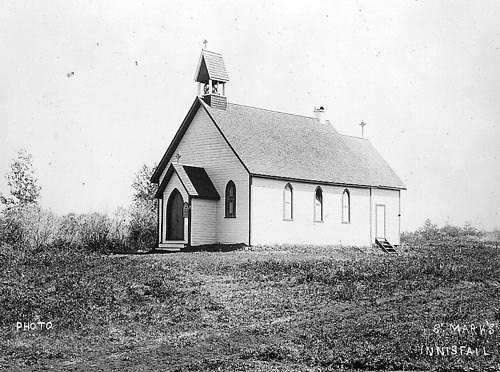On Sunday, April 30th, 2017, St. Mark’s Anglican Church in Innisfail celebrated its 125 anniversary.
It is likely the oldest church building, still standing, between Calgary and Edmonton, and one of the oldest historic structures in Alberta today.
The origins of the Anglican Church in Central Alberta date back to early 1880s when a group of Metis settlers, originally from Headingly, Manitoba, organized an Anglican parish. It was a wonderful example of a ‘grassroots’ congregation, formed on the initiative of the parishioners themselves.
Unfortunately, the congregation struggled to get clergy support as there was a shortage of missionaries in Alberta. Eventually, Rev. Henry Collier was able to provide some regular services, thanks to a grant from the Society for the Propagation of the Gospel.
However, the Metis parishioners also struggled to have their legitimate land claims for their farms recognized by the government because much of their land had been sold to a land company from Ontario. Eventually, most of them dispersed to other places.
In 1891, Rev. Charles Ingles, the energetic rector of St. Mark’s Parkdale in Toronto, agreed to come to Central Alberta for three months to rejuvenate the local Anglican community.
He had enough success that he was able to persuade the Bishop of Saskatchewan and Calgary, Cyprian Pinkham, to assign Harry Bygrave Brashier, a lay reader from St Mark’s Parkdale, to continue the mission work in the area.
The area for which Mr. Brashier was responsible was vast – some 1,000 sq. miles. It extended from Olds in the south to Buffalo Lake in the north and from Pine Lake in the east to Tindastoll (Markerville) in the west.
Brashier decided to base his mission work at Poplar Grove (Innisfail) as that was the largest settlement in the district. In January 1892, he was ordained as a deacon. A few weeks later, on Trinity Sunday (May 28th), he was ordained into the priesthood.
Rev. Brashier, along with a group of dedicated local parishioners, worked hard to build a church in Innisfail. Money was short, but volunteer help and donations were readily forthcoming. Samuel Twissell, one of the first two wardens of the church, donated $16 to have the pulpit specially made by a local craftsman. The church bell was secured from G.W. West, the first storekeeper in Innisfail.
On June 26th, 1892, the first service was held in the church. Rev. W.H. Barnes of Banff travelled to Innisfail for this inaugural service.
Disaster almost struck in the fall of 1892 when an enormous prairie fire, which had started by Gleichen near Calgary, swept northwards. It almost destroyed the hamlet and its new little church. The following year, an economic recession set in. The fledgling parish teetered on the verge of bankruptcy.
Fortunately, through tremendous volunteer commitment and, at times, sheer faith, St. Mark’s made it through the tough times.
In 1899, a parishioner, Robert Miller, lost his life in the Boer War at Ladysmith in South Africa.
A bronze plaque was erected in his memory in the church. In 1916, during the First World War, the 187 Overseas Battalion was raised in Central Alberta. A decision was made to make St. Mark’s the permanent home of the regimental colours.
In 1918, during the terrible Spanish ‘flu epidemic, Rev. John Orton of St. Mark’s distinguished himself to the care and support of the sick and dying.
The rectory was also used as an emergency hospital.
Afterwards, a special gift was made to Rev. Orton for his exemplary service during the crisis.
In 1921, renovations were made to the chancel and a special memorial glass window was installed. In 1928, a parish hall was constructed next to the church.
Over the years, a number of improvements, repairs, extensions and renovations have been made to the church. Nevertheless, the building is much the same as it was 125 years ago.



